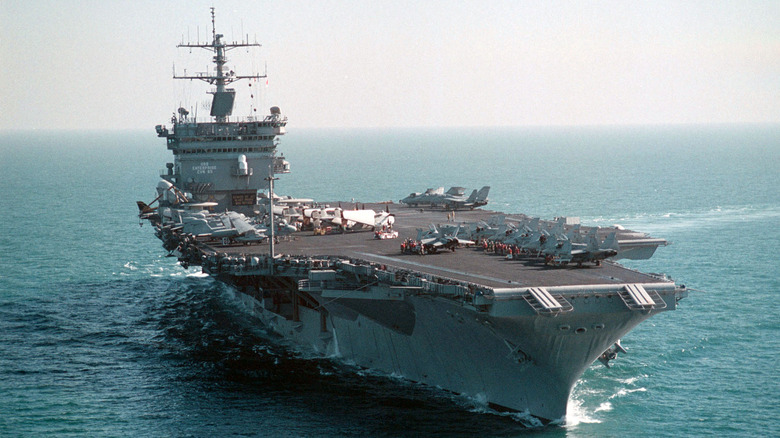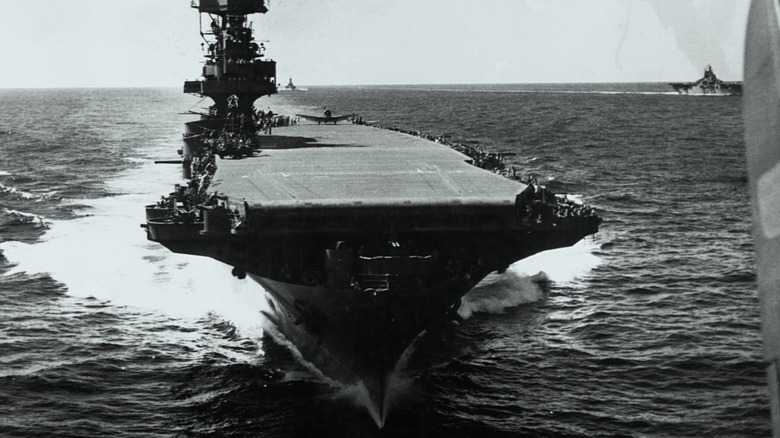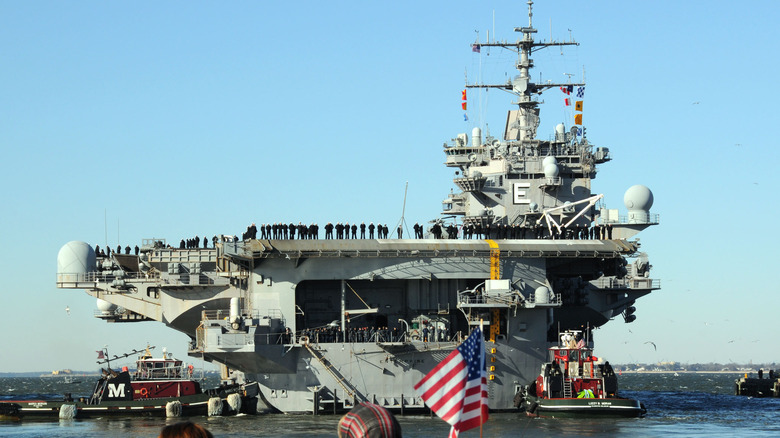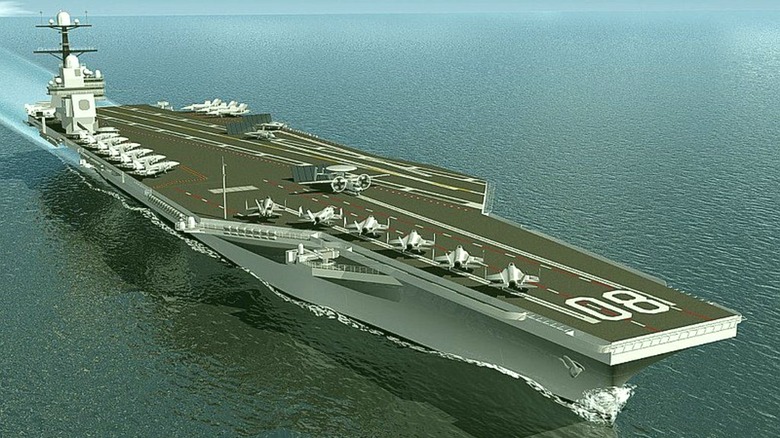How Many USS Enterprise Aircraft Carriers Have There Been, And Are Any In Service?
Thanks to "Star Trek," the most well-known ship in the U.S. Navy is probably the USS Enterprise. There's a reason for that, and while the "Star Trek" franchise has been incredibly successful at putting that name out there, there's plenty of history that goes into naming a ship Enterprise, and there have been several over the years. As of August 2024, three aircraft carriers have been named "Enterprise," though none currently sail.
The first carrier to be named USS Enterprise entered into active service for the Navy in 1938. That vessel, designated CV-6, was a Yorktown-class aircraft carrier that served with distinction throughout World War II, and her record speaks for itself. The USS Enterprise was the most decorated American naval vessel of World War II, so she made a significant impact on American and world history.
The second USS Enterprise aircraft carrier (CVN-65) entered service in 1961, and was the first U.S. aircraft carrier powered by nuclear reactors. That ship was involved in the 1962 Cuban Missile Crisis and Vietnam, among other important engagements. She sailed for more than 50 years before her decommissioning. The third aircraft carrier to be called Enterprise is actually still under construction. A total of eight U.S. Navy vessels bore the name Enterprise, going back to the very first one in 1775, which was a 70-ton sloop-of-war, though it wasn't built by the Americans.
USS Enterprise (CV-6)
The USS Enterprise (CV-6) was a Yorktown-class aircraft carrier. She was much smaller than its successors, weighing in at only 32,000 tons under a full load. She was 908 feet long and housed over 2000 personnel. In terms of aircraft, the Enterprise accommodated between 80 and 90 planes of varying types, and she was heavily armed with a variety of weapon systems, including dozens of .50 caliber machine guns, 20 mm cannons, anti-aircraft defensive weapons, and more.
The USS Enterprise served throughout World War II and was the only carrier of her class to survive the war. She took part in the Doolittle Raid, launching B-25 Mitchells in the first attack on Tokyo, Japan, following the sneak attack at Pearl Harbor on Dec. 7, 1941. The Enterprise also took part in the Battle of Midway, and she had several engagements throughout the Pacific Campaign, including the Battle of the Philippine Sea.
She later supported the Marines during the battles of Iwo Jima and Okinawa, so she was one of the primary American carriers operating in the Pacific throughout WWII. For her service throughout the conflict, the USS Enterprise was awarded an unprecedented 20 battle stars, which was three more than any other ship in the fleet. The Enterprise crew was also the first aircraft carrier to receive the Presidential Unit Citation, and she also received a Navy Unit Commendation after the war.
USS Enterprise (CV-65)
The second aircraft carrier named Enterprise was commissioned on Nov. 25, 1961. She was the first to be powered by nuclear reactors, which set the standard for all American carriers that would follow. Before engaging in any combat operations, the USS Enterprise (CV-65) took part in the Project Mercury Program, tracking and measuring the first U.S. orbital spaceflight. She went on to join the fleet blockading Cuba from the Soviet Union during the Cuban Missile Crisis.
The Enterprise was the first and only of the Enterprise-class of aircraft carriers and remains the longest naval vessel ever built. She was a mind-bending 1,123 feet in length and weighed in at just over 94,000 tons under a full load. Despite her impressive size, the Enterprise was a fast aircraft carrier capable of reaching cruising speeds of 33.6 knots (38.7 mph). That makes her the fastest aircraft carrier the United States has ever operated.
The Enterprise served with distinction for decades, and when she was deactivated in December 2012, she was the third-oldest ship the Navy ever operated after the USS Pueblo and USS Constitution (Old Ironsides). All told, the Enterprise served for more than 55 years, which is five years longer than the Navy expects to utilize its supercarriers. Also, it was the USS Enterprise (CV-65) that inspired "Star Trek" showrunner Gene Roddenberry to change his starship's name from the Yorktown to the Enterprise.
USS Enterprise (CVN-80)
The third aircraft carrier to be called Enterprise began construction in April 2022. She will be the ninth American ship to be called Enterprise and the third aircraft carrier. The Enterprise is the third Gerald R. Ford-class aircraft carrier built for the U.S. Navy, and while she was supposed to be launched in November 2025, that's not going to happen. Delays in production materials and supply chain issues are keeping her from the ocean until at least 2030. When she does finally set sail, she'll likely be the most advanced warship ever built.
The Ford-class carriers are a class that's unequaled by any navy in the world. They're the largest class of warships ever constructed, weighing in at 100,000 tons under a full load. The Enterprise will likely accommodate as many as 90 aircraft of various types, though it will most likely favor the new F-35C Lightning II, which is the U.S.' only fifth-generation carrier-capable fighter aircraft in service.
When she does launch, the USS Enterprise (CVN-80) will take on a name with a great deal of honorable history. Each vessel named Enterprise has served with distinction, and none have been lost to enemy action. For many Americans, even those not familiar with "Star Trek," the name Enterprise commands respect, as it's served the United States well for more than 240 years and will continue to do the same for the foreseeable future.
[Featured image by U.S. Navy via Wikimedia Commons | Cropped and scaled | Public Domain]



